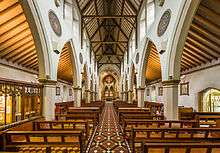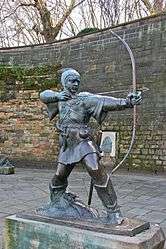Nottingham Cathedral
| Nottingham Cathedral | |
|---|---|
| Saint Barnabas’ Cathedral, Nottingham | |
 | |
 Nottingham Cathedral Shown in Nottingham | |
| 52°57′17″N 1°09′26″W / 52.9547°N 1.1571°WCoordinates: 52°57′17″N 1°09′26″W / 52.9547°N 1.1571°W | |
| Location | Nottingham, Nottinghamshire |
| Country | England |
| Denomination | Roman Catholic |
| Website | stbarnabascathedral.org.uk |
| Architecture | |
| Architect(s) | Augustus Welby Northmore Pugin |
| Years built | 1841-1844 |
| Specifications | |
| Height | 164 feet (50 m) |
| Number of spires | 1 |
| Administration | |
| Diocese | Nottingham (since 1850) |
| Province | Westminster |
| Clergy | |
| Bishop(s) | Patrick McKinney |
| Dean | Geoffrey Hunton |
| Laity | |
| Director of music | Alex Patterson |
| Organist(s) | Robert Gower |
The Cathedral Church of St. Barnabas in the city of Nottingham, England, is a cathedral of the Roman Catholic church. It is the mother church of the Diocese of Nottingham and seat of the Bishop of Nottingham.
Location
It is located on the corner of Derby Road and North Circus Street, on the opposite side of which are the Albert Hall and the Nottingham Playhouse (Wellington Circus).
History


It was built between 1841 and 1844, costing £15,000 (equivalent to £1,350,000 in 2015),[1] and was first consecrated in 1844, fifteen years after the Catholic Relief Act ended most restrictions on Catholicism in the United Kingdom. A substantial amount of the cost was paid by the important Catholic Lord Shrewsbury. The architect was Augustus Welby Northmore Pugin who also designed the interior of The Houses of Parliament. It was built in the Early English Plain Gothic style, although in contrast, the Blessed Sacrament Chapel was richly decorated and Pugin’s later churches were built in that Decorated Gothic style throughout. Pugin was retained as architect by Rev Robert William Willson, then priest in charge of Nottingham. In 1842 he was named as Bishop-Elect of Hobart, Tasmania, and had to leave the work in Nottingham before completion.
Following the establishment of a new Catholic hierarchy in England and Wales in 1850 by the decree of Pope Pius IX, it was raised to cathedral status in 1852, becoming one of the first four Catholic cathedrals in England and Wales since the English Reformation.[2] It is the seat of the Bishop of Nottingham.
The cathedral is a Grade II* listed building of the lancet style of architecture, and is considered to be one of the best specimens of Pugin's work.[3]
The clergy of the Cathedral also serve the church of St. Augustine on Woodborough Road.
Cathedral music


The Cathedral's choral scholarships are available to students above or of eighteen years of age who are in full-time tertiary education in the Nottingham area.[4]
List of Directors of Music
- Edmund Hart Turpin 1850 - 1865
- James Turpin 1866 - 1873[5] (afterwards organist of Londonderry Cathedral)
- William George Taylor 1874 - 1885[6] - 1898[7] - 1905
- William Francis Taylor 1905 - 1963 [8]
- Peter Smedley 1964 - 2003
- Neil Page 2003 - 2014
- Alex Patterson 2014–present.[9]
List of assistant organists
- Peter Smedley 1954 - 1964
Assistant Directors of Music
- Christopher Burton 2008 - 2010
- Paul Hayward 2011 - 2012
- Alex Patterson 2012 - 2014
References
- ↑ UK CPI inflation numbers based on data available from Gregory Clark (2016), "The Annual RPI and Average Earnings for Britain, 1209 to Present (New Series)" MeasuringWorth.
- ↑ Decree of the Sacred Congregation for the Propagation of the Faith, 21 April 1852. The other churches raised to cathedrals by this decree were St George's, Southwark, St Chad's, Birmingham and St John's, Salford: Decreta Quatuor Conciliorum Provincialium Westmonasteriensium, (2nd Edn, London: Burns & Oates), p.56; translation in: Robert Guy OSB, The Synods in English (Stratford-on-Avon: St Gregory Press, 1886) p.101.
- ↑ Cathedral Church of St Barnabas and Attached Boundary Wall, Nottingham from British listed buildings, retrieved 15 May 2015
- ↑ "Choirs". Nottingham Cathedral Music. Retrieved 2016-11-02.
- ↑ Nottinghamshire Guardian - Friday 1 August 1873
- ↑ History, Gazetteer & Directory of Nottinghamshire, 1885, p.445
- ↑ Wright's Directory of Nottingham, 1898-99, p.466
- ↑ Nottingham Cathedral Yesterday and Today, Edward Cocking et al. 2007 p.36
- ↑ "History". Nottingham Cathedral Music. Retrieved 2016-11-02.
External links
| Wikimedia Commons has media related to Nottingham Cathedral. |
- St. Barnabas' Cathedral Official Website
- Nottingham Cathedral Music Website
- Diocese of Nottingham Official Website
- Audio slideshow tour of St. Barnabas' from the BBC

